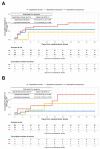Effect of Possible Osteoporosis on Parenchymal-Type Hemorrhagic Transformation in Patients with Cardioembolic Stroke
- PMID: 34200258
- PMCID: PMC8201205
- DOI: 10.3390/jcm10112526
Effect of Possible Osteoporosis on Parenchymal-Type Hemorrhagic Transformation in Patients with Cardioembolic Stroke
Abstract
Background: hemorrhagic transformation (HT) is a frequent complication of ischemic stroke, and parenchymal hematoma (PH)-type HT has been shown to correlate with symptomatic deterioration. Because both bone and vascular smooth muscle cells are composed of type 1 collagen, we hypothesized that the integrity of blood vessels around the infarction area might be more damaged in osteoporotic conditions after a cardioembolic stroke.
Methods: we measured frontal skull Hounsfield unit (HU) values on brain CT images from cardioembolic stroke patients. We conducted a receiver operating characteristic curve analysis in a large sample registry to identify the optimal HU threshold for predicting osteopenia and osteoporosis. Hazard ratios were estimated using a Cox regression analysis to identify whether osteoporotic conditions were an independent predictor of PH-type HT in patients with cardioembolic stroke.
Results: altogether, 600 consecutive patients (>18 years old) with cardioembolic stroke were enrolled over a 12-year period at our hospital. The infarction volume and hypothetical osteoporosis were independent predictive factors for PH-type HT development in patients with cardioembolic stroke. In the male group, hypothetical osteoporosis was an independent predictor for PH-type HT development after cardioembolic stroke (hazard ratio, 4.12; 95% confidence interval, 1.40-12.10; p = 0.010).
Conclusions: our study suggests an association between possible osteoporosis and the development of PH-type HT in patients with cardioembolic stroke. Our findings could help to predict PH-type HT by providing a convenient method for measuring the HU value using brain CT images.
Keywords: Hounsfield unit; bone mineral density; cardioembolic stroke; hemorrhagic transformation; osteoporosis; parenchymal type hematoma.
Conflict of interest statement
The authors declare no conflict of interest.
Figures




References
-
- Fiorelli M., Bastianello S., von Kummer R., del Zoppo G.J., Larrue V., Lesaffre E., Ringleb A.P., Lorenzano S., Manelfe C., Bozzao L. Hemorrhagic Transformation within 36 h of a Cerebral Infarct: Relationships with Early Clinical Deterioration and 3-Month Outcome in the European Cooperative Acute Stroke Study I (ECASS I) Cohort. Stroke. 1999;30:2280–2284. doi: 10.1161/01.STR.30.11.2280. - DOI - PubMed
Grants and funding
LinkOut - more resources
Full Text Sources

